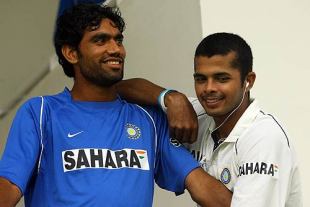India's fast bowlers face fitness crisis
|
|

|
Irfan Pathan in 2003, L Balaji in early 2004, Sreesanth in 2005, Munaf Patel in 2006, and RP Singh in 2007. Over the last five years Indian fast bowlers have emerged, won Tests, sustained injuries, got dropped, made comebacks, and got injured again. Somewhere along the line, Zaheer Khan was reaffirmed as the spearhead of the attack while Ashish Nehra has been forgotten. India's fast-bowling machinery resembles a political sham: promising much before fizzling out.
A series is beginning tomorrow and India have one dependable quick (Zaheer), another erratic one who is coming back from injury (Munaf), and a tyro who has also only recently recovered (Ishant Sharma). Sreesanth, a proven match-winner, is injured, along with RP Singh, who was a revelation on the England tour. Pathan has been sent back to the grind of domestic cricket, and VRV Singh, a young fast bowler, also has injury problems. Ranadeb Bose, the highest wicket-taker in the 2006-07 Ranji Trophy, has shown signs of being a limited medium-pacer while Ishant will need to add control and movement if he expects to cut it at the highest level.
With seven challenging Tests ahead - the final four in Australia will require them to play three fast bowlers - India have to address several serious questions. When their first-choice fast bowlers are fit, both physically and mentally, India have a handy and even threatening pace attack. But bowling fast is an injury-prone business and the Indian bowlers have proven to be more brittle than most. And when a couple of them get injured, the thinness of India's bench-strength has been exposed.
The irony is that India's success away from home this decade has been dependent on their fast bowlers. Pathan and Balaji played significant roles in the historic victory in Pakistan in 2003-04, while Rahul Dravid felt Munaf and Sreesanth had performed better than any other pair over the previous ten years during the 2006 tour to West Indies. Sreesanth single-handedly swung the Wanderers Test in India's favour last year, and England's batsmen struggled to pick the prodigious swing from RP Singh and Zaheer this summer.
So have India handled their bowlers judiciously? RP's case gives us a few answers. Over the last five months he's bowled 268 overs in 18 one-dayers, three Tests and the World Twenty20. Sreesanth, dropped for the ODIs in England, and Zaheer, who missed the World Twenty20, at least had enforced breaks. Nobody, it seems, thought of giving RP a decent rest.
Munaf's case is even more damning. He was a problem during the ODI series in England for which he was chosen even though he wasn't fully fit. Venkatesh Prasad, India's bowling coach, openly questioned Munaf's inclusion and suggested he wasn't impressed with the selection. That was the latest in a long line of injuries that have blighted Munaf and nobody, it seemed, could determine when he was fit. Now, on the back of only three first-class games, one of which was a poor performance in the Irani Trophy, he's almost certain to share the new ball in the first Test which begins tomorrow.
The most worrying aspect, with less than a month to go for the tour of Australia, is the lack of fast-bowling options. The recent Challenger Trophy showed the paucity of talent - Pankaj Singh and V Yomahesh impressed but have a long way to go before being selected- and it's tough to imagine Praveen Kumar and Joginder Sharma surviving Test cricket.
Apart from winning against Pakistan, India also need to ensure against injuries over a possible 15 days Test cricket and hope that their crocked personnel return stronger. He's yet to turn on the ignition but Kumble must already feel like a racer driving on empty. After 17 years, though, he may be used to it.
Siddhartha Vaidyanathan is an assistant editor at Cricinfo
